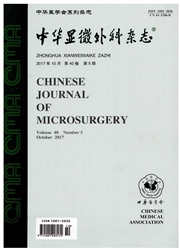

 中文摘要:
中文摘要:
目的 探讨利用脊髓损伤平面以上正常的脊神经前根与支配股四头肌的优势腰神经前根吻合,重建脊髓损伤大鼠的股四头肌神经通路,恢复脊髓损伤大鼠肢体部分运动功能的效果.方法取4周龄SD大鼠20只,体重120~150 g;左侧为实验侧,右侧为对照侧.将大鼠左侧L1~L5脊神经根分别进行电刺激,根据股四头肌肌电图的检测结果,得出支配股四头肌优势神经根.将左侧L1神经前根与股四头肌优势脊神经前根通过尾神经桥接吻合,重建大鼠股四头肌的神经通路,右侧不作任何处理.术后6个月,在切断左侧L2脊髓水平制备大鼠脊髓损伤模型前后,分别进行电生理检测,饲养4周后进行电刺激大鼠股四头肌运动情况观察,BBB评分及后肢运动观察.结果 16只大鼠存活至术后6个月,10只大鼠成功分离出吻合的神经根,获得实验结果.实验侧截瘫前、后,单相方波(2.5 mA,0.2ms,1 Hz)刺激神经吻合段,均可记录到股四头肌动作电位,波幅分别为(7.63±1.86)mV和(6.00±1.92)mV,差异无统计学意义(P>0.05);对照侧截瘫后电刺激L3脊神经根,引出的股四头肌动作电位波幅为(15.87±1.16)mV,均大于实验侧截瘫前后股四头肌动作电位波幅(P<0.05).截瘫后饲养4周,观察大鼠实验侧后肢平地能完成爬行动作,登高时能完成攀高动作;截瘫后1、3、7、14、21、28 d观察后肢运动功能的BBB评分,BBB评分值在伤后1、3、7 d时间点差异均有统计学意义(P<0.05),在14、21、28 d时间点差异无统计学意义.结论 利用截瘫平面以上健存的脊神经根,通过尾神经桥接吻合股四头肌优势支配神经根,可建立股四头肌新的脊髓旁神经通路,有望实现截瘫患者下肢部分的运动功能.
 英文摘要:
英文摘要:
Objective To establish a paraspinal neural pathway of quadriceps femoris by end-to-end anastomoses between the spinal ventral root after spinal cord injury(SCI) in rats. Methods Twenty-fourweek old SD rats, with the weight of 120 g to 150 g, were included. The left side was the experimental side, while the right side served as a control. Electrostimulating of L1-L5 ventral root was done respectively to decide the predominant nerve of quadriceps femoris. The lumbar 1 ventral root was reveal to little innervation of quadriceps femoris, and the lumbar 3 ventral root was predominant innervation. End-to-end anastomosis between the left L1 and L3 ventral root was done. After axona regeneration, the new paraspinal neural pathway of quadriceps femoris was established. At 6 months postoperatively, the early function of the new pathway was observed by electrophysiological examinations, hindlimb locomotion and BBB (basso, beattie and bresnahan)scale at 1,3,7, 14,21,28 d after SCI. Results Sixteen rats survived for 6 months after operation and only ten rats got good results because of tissue adhesion postoperatively. Single stimuli (2.5 mA,0.2 ms, 1 Hz) of the left anastomoses nerve resulted in action potential recorded from the left quadriceps femoris before and after the spinal cord hemisection horizontally between L2 segmental levels. The amplitudes of the action potentials were (7.63 ± 1.86) mV and (6.00 ± 1.92)mV, respectively, and there was no significant difference (P 〉 0.05). The left quadriceps femoris contraction was initiated by single stimuli (2.5mA, 0.2 ms, 1 Hz) of the left anastomoses nerve. After paraplegia, when the right L3 ventral root was stimulated, the amplitude of the action potential was (15.87 ± 1.16) mV. Locomotion of the left hindlimb was partially restored after spinal cord hemisection while creeping and climbing. According to BBB scale, there was significant difference at 1, 3, 7 d, and little difference at 14, 21, 28 d after SCI. Conclusion Spinal ventral roo
 同期刊论文项目
同期刊论文项目
 同项目期刊论文
同项目期刊论文
 期刊信息
期刊信息
